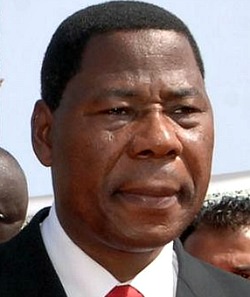 The Republic of Benin (formerly, Dahomey) is a West African country bordering the Bight of Benin (or 'Bay of Benin') on the West African coast between the Federal Republic of Nigeria (to the east) and the Republic of Togo (to the west). To the North, Benin borders the Republics of Burkina Faso and Niger.
The Republic of Benin (formerly, Dahomey) is a West African country bordering the Bight of Benin (or 'Bay of Benin') on the West African coast between the Federal Republic of Nigeria (to the east) and the Republic of Togo (to the west). To the North, Benin borders the Republics of Burkina Faso and Niger.
The Republic of Benin has a total land area of about 113,622sq km (about 2,000sq km of which is covered by water) with about 121km of coastline. Just about 23.53% of the total land area of Benin remains arable (land good for farming).
The Republic of Benin has a total population of about 11.5 million people with the population growth rate hovering around 2.7%. About half of the total population of Benin lives in urban areas in major cities and towns such as Cotonou the seat of government (Cotonou contains about 1 million people) and Porto-Novo the capital of Benin (Porto-Novo contains about 400,000 people).
Although a small country, the Republic of Benin is one of the most culturally rich countries in all of Africa with several ethnic and racial groups living together. The Fon and related ethnic groups make up about 39.2% of the total population. The Adja and related ethnic groups make up about 15.2% of the population. The Yoruba and related ethnic groups together form about 12.3% of the total population. The Bariba and related make up about 9.2%, the Peuls about 7%, the Ottamari and related form about 6.1% of the total population while the Dendi, and other ethnic groups make up the remaining fraction of the population.
Although French remains the official language of Benin, Fon, Yoruba, and several other local languages are written and spoken in Benin today. Benin is the motherland of voodoo. In fact, voodoo is the state religion of Benin. However, only about 17.3% of the total population claim voodoo or vodoun as their major religion. About 42.8% of the total population are Christians (including Catholics and protestants). Muslims form about 24.4% of the total population.
The Republic of Benin just like its neighboring countries is blessed with abundance of natural resources including marble, timber, limestone, and some offshore oil deposits.
However, despite the abundance of natural resources, the Republic of Benin remains one of the poorest countries in Africa today. In terms of literacy, Benin has one of the worst literacy rates on the continent. Benin has a literacy rate of just 34.7% for the total population with the female literacy rate hovering around 23.3%. In other words, just about 34.7% of the total population of Benin above age 15 can read and write. And just about 23.3% of the total population of females above the age 15 can read and write which is very bad.
Drinking water and water for domestic purposes remain a major issue in Benin today. Most water bodies in Benin today are polluted (caused mainly by agricultural and industrial runoffs and improper sewage disposals) and some communities across the country lack total access to clean drinking water.
Most farmers in Benin are subsistence farmers who grow crops and rear animals just to feed themselves and their families. In times of crop failure (caused mainly by unpredictable climatic conditions such droughts, floods, etc), many families (especially those in the rural areas) are left with nothing but poverty and despair.
Rampant deforestation, desertification, and poaching remain some of the major environmental issues facing Benin today.
The Republic of Benin has an HIV/AIDS adult prevalence rate or 1.2%. More than 60,000 people were living with HIV/AIDS in 2009 with about 3000 deaths recorded within the same year. Besides HIV/AIDS, the deadly malaria, hepatitis A, typhoid fever, yellow fever, meningococcal meningitis, and animal contact diseases such as rabies continue to threaten several lives in Benin today.
Just like in most other African countries, corruption, poor governance, etc. continue to tear Benin apart.
